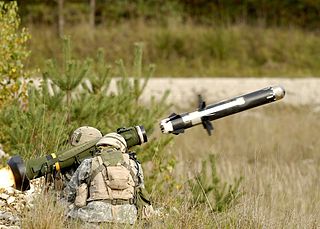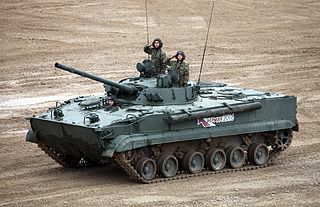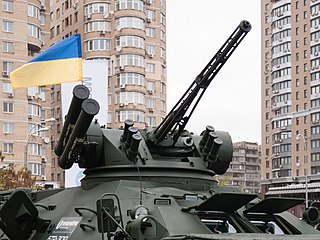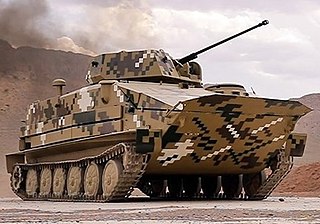Related Research Articles

An anti-tank guided missile (ATGM), anti-tank missile, anti-tank guided weapon (ATGW) or anti-armor guided weapon is a guided missile primarily designed to hit and destroy heavily armored military vehicles. ATGMs range in size from shoulder-launched weapons, which can be transported by a single soldier, to larger tripod-mounted weapons, which require a squad or team to transport and fire, to vehicle and aircraft mounted missile systems.

The BMP-3 is a Soviet and Russian infantry fighting vehicle, successor to the BMP-1 and BMP-2. The abbreviation BMP stands for Boevaya Mashina Pekhoty.

The BMP-1 is a Soviet amphibious tracked infantry fighting vehicle that has been in service from 1966 to the present. BMP stands for Boyevaya Mashina Pyekhoty 1, meaning "infantry fighting vehicle, 1st serial model". The BMP-1 was the first mass-produced infantry fighting vehicle (IFV) of the Soviet Union. It was called the M-1967, BMP and BMP-76PB by NATO before its correct designation was known.

Missile d'Infanterie Léger Antichar or MILAN is a Franco-West German anti-tank guided missile system. Design of the MILAN began in 1962; it was ready for trials in 1971, and accepted for service in 1972. It is a wire-guided semi-automatic command to line of sight (SACLOS) missile, which means the sight of the launch unit must be aimed at a target to guide the missile. The MILAN can be equipped with a MIRA or MILIS thermal sight to give it night-firing ability.

Eryx is a French short-range portable semi-automatic command to line of sight (SACLOS) based wire-guided anti-tank missile (ATGM) manufactured by MBDA France and by MKEK under licence. The weapon can also be used against larger bunkers and smaller pillboxes. It also has some anti-aircraft warfare ability, to bring down low flying helicopters, due to its wire-guidance system. An agreement was reached in 1989 between the French and Canadian governments to coproduce the Eryx missile system.

The HOT is a second-generation long-range anti-tank missile system. It was originally developed to replace the older SS.11 wire guided missile in French and West German service. The design was a collaboration between the German firm Bölkow and the French firm Nord. Bölkow and Nord later merged into MBB and Aérospatiale respectively, both of which then formed Euromissile to design and produce the MILAN, Roland and HOT. This ultimately became part of MBDA.

The 9M14 Malyutka is a manual command to line of sight (MCLOS) wire-guided anti-tank guided missile (ATGM) system developed in the Soviet Union. It was the first man-portable anti-tank guided missile of the Soviet Union and is probably the most widely produced ATGM of all time—with Soviet production peaking at 25,000 missiles a year during the 1960s and 1970s. In addition, copies of the missile have been manufactured under various names by at least six countries.

The 3M11Fleyta is a Soviet MCLOS radio command anti-tank missile. Various improved versions were designated 9M17Falanga

9K114 Shturm - is a SACLOS radio guided anti-tank missile system of the Soviet Union. Its GRAU designation is 9K114. Its NATO reporting name is AT-6 Spiral. The missile itself is known as the 9M114 Kokon (Cocoon).

The 9M120 Ataka is an anti-tank guided missile (ATGM) originating from the Soviet Union. The NATO reporting name of the 9M120 missile is the AT-9 Spiral-2. It is the next major generation in the 9K114 Shturm family. The missile has radio command guidance and is also a beam riding SACLOS. This missile's primary variant was designed to defeat tanks with composite armour and explosive reactive armor. The 9M120 Ataka system is often confused with the 9K121 Vikhr system, despite being different weapons systems developed by different companies. The former was designed by the KBM machine-building design bureau and manufactured by the Degtyarev plant. According to the Stockholm International Peace Research Institute, Russia exported the Ataka ATGM to Iran, Kazakhstan, and Slovenia.

The 9K112 Kobra is a SACLOS anti-tank missile system of the Soviet Union. It is fired from the 125 mm main guns of the T-64 and T-80 series of tanks. A newer design based on the same concept is the 9M119.

The 9M123 Khrizantema is a Russian anti-tank guided missile (ATGM). Khrizantema was designed to deal with current and future generations of main battle tanks and can also be used to engage slow and low flying aerial targets like helicopters. The 9M123 missile, and its associated guidance system, forms the 9K123 missile system.

The RBS 56B BILL 2 Anti-Tank Guided Weapon is a man-portable or vehicle-mounted guided anti-tank missile using the overfly top attack method to attack the weaker parts of an armoured vehicle. BILL is acronym for Bofors Infantry Light & Lethal.

The Raad or RAAD is an Iranian wire-guided anti-tank guided missile based on the Soviet 9M14M Malyutka missile. The Raad began mass production in 1988 and was publicly unveiled in 1997. It is manufactured by Parchin Missile Industries, a subsidiary of Iran's Defense Industries Organization.

The BMPT "Terminator" is an armored fighting vehicle (AFV), designed and manufactured by the Russian company Uralvagonzavod. This vehicle was designed for supporting tanks and other AFVs in urban areas. The BMPT is unofficially named the "Terminator" by the manufacturers. It is heavily armed and armored to survive in urban combat. The AFV is armed with four 9M120 Ataka missile launchers, two 30 mm 2A42 autocannons, two AG-17D grenade launchers, and one coaxial 7.62 mm PKTM machine gun.

The Shipunov 2A42 is a Soviet/Russian 30 mm autocannon. It is built by the Tulamashzavod Joint Stock Company and named after A. G. Shipunov.

The Fahd is a 4x4 Egyptian armored personnel carrier, designed to fit the requirements of the Egyptian Military. It replaced older APCs in Egyptian service such as the BTR-40, and the Walid. It has been used by the United Nations.

The Shturm turret is a remotely controlled turret, developed in Ukraine, for light armored vehicles. The turret adds 1,300 kilograms (2,900 lb) to a vehicle's weight. The turret was developed at the Kyiv Armoured Plant, in Kyiv. The turret is armed with a ZTM-1 30mm autocannon, coaxial 7.62 machine gun, smoke grenades, and a launcher for a pair of anti-tank missiles.

The Makran IFV, an Iranian armoured personnel carrier (APC), is the highly modernized and upsized copy of the BTR-50 APC. The vehicle is produced and designed by the Research and Self-Sufficiency Jihad Organization. It was unveiled in June 2020 by the Islamic Revolutionary Guard Corps. The vehicle is named after the Makran coastal region, a region that stretches between Iran and Pakistan. While the Makran is technically an infantry fighting vehicle, it has a large troop compartment as it is based on the BTR-50, allowing it to dual function as an armoured personnel carrier.
References
- 1 2 3 4 5 6 "2T Stalker Combat Vehicle Reconnaissance". Minotor Service. Archived from the original on 25 February 2009. Retrieved 2009-02-08.
- 1 2 3 "2T Stalker Armored Reconnaissance Vehicle". Military Today. Archived from the original on 7 February 2009. Retrieved 2009-02-08.
- ↑ "2T Stalker Combat Vehicle Reconnaissance". Monitor Service. Archived from the original on 25 February 2009. Retrieved 2009-02-08.
- 1 2 3 4 5 "2A42 30 mm cannon (Russian Federation), Cannon". Jane's Information Group. Retrieved 2009-02-08.
- 1 2 3 4 "30mm 2A42 Automatic Cannon". KBP in focus. Archived from the original on 2009-05-04. Retrieved 2009-02-08.
- 1 2 3 "2A42". Deagel. Archived from the original on 2 March 2009. Retrieved 2009-02-08.
- 1 2 3 4 "AT - 6 SPIRAL Anti-Tank Guided Missile". Federation of American Scientists (FAS). Archived from the original on 23 February 2009. Retrieved 2009-02-08.
- ↑ "rocket and missile system". Encyclopædia Britannica. Archived from the original on 5 March 2009. Retrieved 2009-02-08.
- ↑ "9M114". Deagel. Retrieved 2009-02-08.
- 1 2 "Shturm (NATO AT-6 Spiral) Anti-Tank Missile System". Minotor Service. Archived from the original on 3 March 2009. Retrieved 2009-02-08.
- ↑ "AT Weapon INFO". Center for Arms Control, Energy and Environmental Studies. Archived from the original on 2009-01-29. Retrieved 2009-02-08.
- ↑ "Shturm Self Propelled Anti-Tank Guided Missile System, Russia". Army Technology. Archived from the original on 9 February 2009. Retrieved 2009-02-08.
- ↑ "Missile 9M39". V.A. Degtyarev Plant. Retrieved 2009-11-23.
- ↑ "Missile 9M39". V.A. Degtyarev Plant. Archived from the original on 9 February 2009. Retrieved 2009-02-08.
- 1 2 "IGLA 9K38 Man-Portable Air Defence Missile System". KB Mashynostroyeniya (KBM). Archived from the original on June 28, 2009. Retrieved 2009-11-23.
- ↑ "Igla (NATO SA-18 Grouse) Surface-to-Air Missile System". Minotor Service. Archived from the original on 22 November 2009. Retrieved 2009-11-23.
- ↑ "SA-18 GROUSE Igla 9K38". Federation of American Scientists (FAS) . Retrieved 2009-11-23.